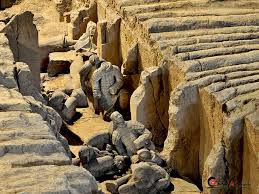
Terracotta Army Pit 2
The Terracotta Army Pit 2 in Xi'an is located about 20 meters (about 66 feet) northeast of Pit 1 and about 120 meters (about 394 feet) east of Pit 3. While not as massive as Pit 1, Pit 2 is by far the most fascinating of the Terracotta Army pits unearthed to date, containing terracotta figures of infantry, cavalry, chariots, and archers.
Terracotta Army Pit 2 Facts
Pit 2 covers an area of about 6,000 square meters (7,176 square yards) in an "L" shape, about 96 meters (105 yards) long from east to west and about 84 meters (92 yards) wide from north to south, with a depth of 5 meters (16 feet). Currently, only one-sixth of the pit has been excavated, while other sections have been partially unearthed, revealing traces of wooden canopies. This Terracotta Warriors Pit 2 was discovered in May 1976 and opened to tourists on October 1, 1994.
A Large-scale Underground Military Complex
Pit 2 is the most spectacular of the three Terracotta Army pits, boasting a more complex battle formation and a more complete range of army units than Pit 1. According to preliminary estimates, there are more than 80 chariots, about 1,300 terracotta figures, and thousands of bronze weapons in the pit. The first discovery of general figurines, kneeling archers, and saddle horses is an eye-opener. There are two ramp entrances on the north side of Pit 2 and four on each side of the east and west ends.
Terracotta Army Pit 2 Military Formation
Northeast Archer Array
This array is square in shape with four corridors on four sides, with standing archers inside. There are four east-west passages in the center of the square, with 160 kneeling archers arranged in a squatting position. In 1999, a unique green-faced terracotta figure and the famous colored terracotta figures were discovered in this array.
Learn more about the Real Face of the Terracotta Army
Figures of Terracotta Army on Display in Xi'an
- Terracotta Army Kneeling Archer
- Green-faced Terracotta Warrior
- Color Painted Terracotta Warriors
South Array
This array, 52 meters (57 yards) long from east to west and 48 meters (53 yards) wide from north to south, consists of 64 chariots in a formation of eight columns, with each chariot being pulled by four life-size pottery horses. Three charioteers stand side by side behind the chariot, with the middle one driving and the others standing on either side.
Infantry, Cavalry, and Chariot Columns in the Center
This is a rectangular battle formation consisting of 264 infantrymen, eight cavalrymen, and 19 chariots. The formation is divided into three groups. A cavalryman stands in front of his horse, with one hand drawing a bow and the other holding the reins. In addition, eight to 36 infantrymen stand behind each chariot.
Cavalry and Chariot Array in the Northwest
The unearthed cavalry warriors in Pit 2 The unearthed cavalry warriors in Pit 2 This array has three east-west passages with all the chariots, cavalrymen, and horses arranged in a line, 50 meters (55 yards) long from east to west and 23 meters (25 yards) wide from north to south.
See more about the Terracotta Army Military Formation
Terracotta Army Pit 2 Exhibition Hall
There is a large exhibition hall beside the pit displaying many cultural relics unearthed from Pit 2, including many representative pottery figures and Qin weapons, such as the Terracotta General, Terracotta Cavalry, bronze swords, and painted terracotta figures.
Tips
It's common to start a tour of the Terracotta Army with a visit to Pit 1. Then, travelers will generally visit Pit 3 and Pit 2 in that order, as the entrance to Pit 2 is not far from the exit of Pit 3.
FAQs about Terracotta Army Pit 2
Q: What makes Terracotta Army Pit 2 unique compared to the other pits?
A: While smaller than Pit 1, Pit 2 stands out for its intricate battle formations, a wider variety of figures (including the first-ever discoveries of generals, kneeling archers, and saddle horses), and the presence of chariots. It offers a more comprehensive insight into ancient Chinese military tactics and organization.
Q: What is the significance of the different military arrays found in Pit 2?
A: Each array, with its specific combination of warriors, chariots, and weaponry, represents a distinct tactical unit within the Qin army. For instance, the archer arrays highlight the importance of ranged combat, while the chariot and cavalry formations demonstrate the emphasis on speed and maneuverability.
Q: Why is only a portion of Pit 2 currently excavated?
A: The decision to leave a significant part of Pit 2 unexcavated stems from a commitment to preservation. Archaeologists and conservationists aim to develop more advanced techniques to excavate and preserve the delicate pigments and materials of the figures and artifacts before uncovering the remaining sections.